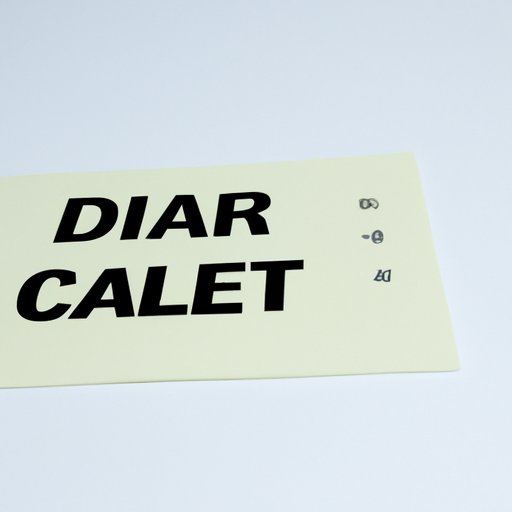Introduction
A calorie deficit is when you burn more calories than you consume. This type of deficit can have many health benefits, such as helping you lose weight and improving your overall health. In this article, we’ll explore what a healthy calorie deficit is, discuss the benefits of creating one, and provide tips for creating and maintaining a calorie deficit.
What is a Calorie Deficit?
A calorie deficit occurs when you burn more calories than you consume. It is important to note that a calorie deficit does not necessarily mean eating fewer calories than usual; it means burning more calories than you consume. This can be done by reducing calorie intake, increasing physical activity, or both. The goal of creating a calorie deficit is to create an energy imbalance in which the body uses stored energy (fat) to make up for the difference.

Benefits of a Healthy Calorie Deficit
Creating a calorie deficit through healthy habits can have numerous health benefits. One of the most well-known benefits is weight loss. A study published in 2018 found that participants who consumed fewer calories than they burned lost an average of 8.8 pounds over 12 weeks. Other potential benefits include improved metabolic health, increased energy levels, and improved heart health.
How to Create and Maintain a Healthy Calorie Deficit
Creating and maintaining a healthy calorie deficit requires some planning and dedication. Here are some tips for getting started:
Calculating Your Personal Calorie Deficit
The first step to creating a calorie deficit is calculating your personal calorie needs. To do this, you need to know your basal metabolic rate (BMR), which is the number of calories your body needs to maintain basic functions. You can calculate your BMR using an online calculator or by consulting a nutritionist or dietitian. Once you know your BMR, you can subtract a certain number of calories from it to create your calorie deficit.
Understanding the Different Types of Calorie Deficits
There are several different types of calorie deficits, ranging from mild to extreme. A mild calorie deficit involves cutting back on calories by 10-20%, while an extreme calorie deficit involves cutting back on calories by 50% or more. It is important to understand the differences between these types of calorie deficits and choose the one that best fits your goals and lifestyle.
Creating a Calorie Deficit Meal Plan
Once you’ve determined your calorie deficit, the next step is to create a meal plan that meets your needs. This should include healthy, nutrient-dense foods that will help you meet your calorie goals without feeling deprived. Eating a variety of whole foods, such as fruits, vegetables, lean proteins, and healthy fats, can help you reach your goals without sacrificing flavor or satisfaction. You may also want to consider tracking your food intake to ensure you are meeting your calorie goals.
What is the Optimal Calorie Deficit for Weight Loss?
The optimal calorie deficit for weight loss depends on several factors, including age, gender, activity level, and medical history. Generally speaking, a calorie deficit of 20-25% is considered optimal for weight loss. However, it is important to consult with a healthcare professional before starting a calorie deficit program, as they can help you determine the right amount of calories for your individual needs.
Different Approaches to Weight Loss
When it comes to weight loss, there are several different approaches you can take. For example, some people find success with intermittent fasting, while others prefer to spread out their meals throughout the day. No matter which approach you take, the goal should always be to create a healthy calorie deficit.
The Optimal Amount of Calories for Weight Loss
In general, experts recommend aiming for a calorie deficit of 20-25% for weight loss. This means that if your BMR is 2,000 calories, you should aim to consume 1,500-1,750 calories per day. It is important to remember that everyone is different and the optimal calorie deficit for weight loss may vary from person to person.

Common Misconceptions about Calorie Deficits
There are several misconceptions about calorie deficits that can lead to confusion and misinformation. Here are some of the most common misconceptions about calorie deficits:
Calorie Deficits are Unhealthy
One of the most common misconceptions about calorie deficits is that they are unhealthy. However, this is not true. As long as you create a calorie deficit through healthy habits, such as eating nutritious foods and exercising regularly, a calorie deficit can be beneficial for your overall health.
You Must Exercise to Create a Calorie Deficit
Another common misconception is that you must exercise to create a calorie deficit. While exercising can help create a calorie deficit, it is not necessary. Eating fewer calories than you burn is enough to create a calorie deficit.
Conclusion
A healthy calorie deficit can have numerous health benefits, such as weight loss and improved metabolic health. To create a healthy calorie deficit, it is important to calculate your BMR and create a meal plan that meets your caloric needs. Additionally, it is important to remember that the optimal calorie deficit for weight loss may vary from person to person. Lastly, it is important to dispel any misconceptions about calorie deficits, such as the idea that they are unhealthy or that you must exercise to create one.
In conclusion, creating and maintaining a healthy calorie deficit can be beneficial for your overall health. By understanding what a calorie deficit is and how to create and maintain one, you can achieve your health and fitness goals.
(Note: Is this article not meeting your expectations? Do you have knowledge or insights to share? Unlock new opportunities and expand your reach by joining our authors team. Click Registration to join us and share your expertise with our readers.)
